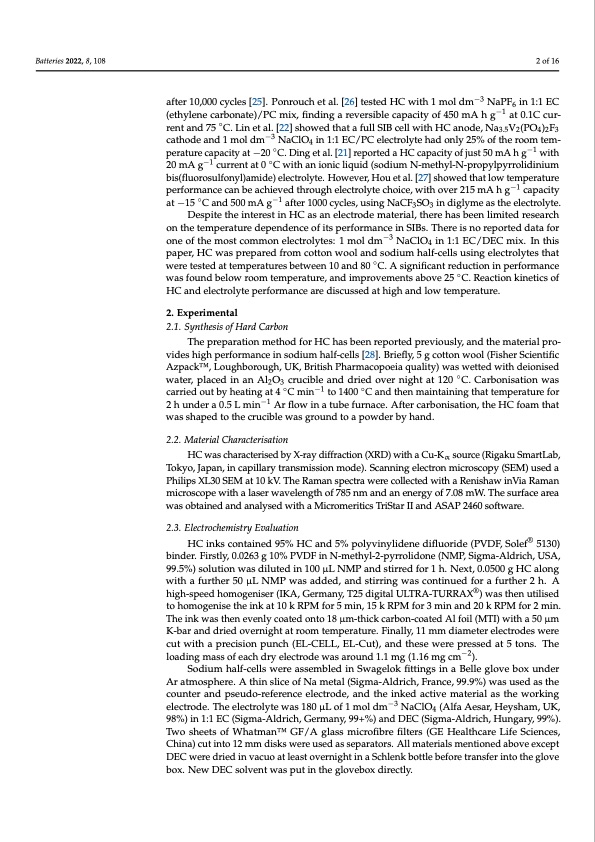
PDF Publication Title:
Text from PDF Page: 002
Batteries 2022, 8, 108 2 of 16 after 10,000 cycles [25]. Ponrouch et al. [26] tested HC with 1 mol dm−3 NaPF6 in 1:1 EC (ethylene carbonate)/PC mix, finding a reversible capacity of 450 mA h g−1 at 0.1C cur- rent and 75 ◦C. Lin et al. [22] showed that a full SIB cell with HC anode, Na3.5V2(PO4)2F3 cathode and 1 mol dm−3 NaClO4 in 1:1 EC/PC electrolyte had only 25% of the room tem- perature capacity at −20 ◦C. Ding et al. [21] reported a HC capacity of just 50 mA h g−1 with 20 mA g−1 current at 0 ◦C with an ionic liquid (sodium N-methyl-N-propylpyrrolidinium bis(fluorosulfonyl)amide) electrolyte. However, Hou et al. [27] showed that low temperature performance can be achieved through electrolyte choice, with over 215 mA h g−1 capacity at −15 ◦C and 500 mA g−1 after 1000 cycles, using NaCF3SO3 in diglyme as the electrolyte. Despite the interest in HC as an electrode material, there has been limited research on the temperature dependence of its performance in SIBs. There is no reported data for one of the most common electrolytes: 1 mol dm−3 NaClO4 in 1:1 EC/DEC mix. In this paper, HC was prepared from cotton wool and sodium half-cells using electrolytes that were tested at temperatures between 10 and 80 ◦C. A significant reduction in performance was found below room temperature, and improvements above 25 ◦C. Reaction kinetics of HC and electrolyte performance are discussed at high and low temperature. 2. Experimental 2.1. Synthesis of Hard Carbon The preparation method for HC has been reported previously, and the material pro- vides high performance in sodium half-cells [28]. Briefly, 5 g cotton wool (Fisher Scientific AzpackTM, Loughborough, UK, British Pharmacopoeia quality) was wetted with deionised water, placed in an Al2O3 crucible and dried over night at 120 ◦C. Carbonisation was carried out by heating at 4 ◦C min−1 to 1400 ◦C and then maintaining that temperature for 2 h under a 0.5 L min−1 Ar flow in a tube furnace. After carbonisation, the HC foam that was shaped to the crucible was ground to a powder by hand. 2.2. Material Characterisation HC was characterised by X-ray diffraction (XRD) with a Cu-Kα source (Rigaku SmartLab, Tokyo, Japan, in capillary transmission mode). Scanning electron microscopy (SEM) used a Philips XL30 SEM at 10 kV. The Raman spectra were collected with a Renishaw inVia Raman microscope with a laser wavelength of 785 nm and an energy of 7.08 mW. The surface area was obtained and analysed with a Micromeritics TriStar II and ASAP 2460 software. 2.3. Electrochemistry Evaluation HC inks contained 95% HC and 5% polyvinylidene difluoride (PVDF, Solef® 5130) binder. Firstly, 0.0263 g 10% PVDF in N-methyl-2-pyrrolidone (NMP, Sigma-Aldrich, USA, 99.5%) solution was diluted in 100 μL NMP and stirred for 1 h. Next, 0.0500 g HC along with a further 50 μL NMP was added, and stirring was continued for a further 2 h. A high-speed homogeniser (IKA, Germany, T25 digital ULTRA-TURRAX®) was then utilised to homogenise the ink at 10 k RPM for 5 min, 15 k RPM for 3 min and 20 k RPM for 2 min. The ink was then evenly coated onto 18 μm-thick carbon-coated Al foil (MTI) with a 50 μm K-bar and dried overnight at room temperature. Finally, 11 mm diameter electrodes were cut with a precision punch (EL-CELL, EL-Cut), and these were pressed at 5 tons. The loading mass of each dry electrode was around 1.1 mg (1.16 mg cm−2). Sodium half-cells were assembled in Swagelok fittings in a Belle glove box under Ar atmosphere. A thin slice of Na metal (Sigma-Aldrich, France, 99.9%) was used as the counter and pseudo-reference electrode, and the inked active material as the working electrode. The electrolyte was 180 μL of 1 mol dm−3 NaClO4 (Alfa Aesar, Heysham, UK, 98%) in 1:1 EC (Sigma-Aldrich, Germany, 99+%) and DEC (Sigma-Aldrich, Hungary, 99%). Two sheets of WhatmanTM GF/A glass microfibre filters (GE Healthcare Life Sciences, China) cut into 12 mm disks were used as separators. All materials mentioned above except DEC were dried in vacuo at least overnight in a Schlenk bottle before transfer into the glove box. New DEC solvent was put in the glovebox directly.PDF Image | Temperature Dependence of Hard Carbon Sodium Half-Cells

PDF Search Title:
Temperature Dependence of Hard Carbon Sodium Half-CellsOriginal File Name Searched:
batteries_08_00108_v2.pdfDIY PDF Search: Google It | Yahoo | Bing
Salgenx Redox Flow Battery Technology: Salt water flow battery technology with low cost and great energy density that can be used for power storage and thermal storage. Let us de-risk your production using our license. Our aqueous flow battery is less cost than Tesla Megapack and available faster. Redox flow battery. No membrane needed like with Vanadium, or Bromine. Salgenx flow battery
| CONTACT TEL: 608-238-6001 Email: greg@salgenx.com | RSS | AMP |